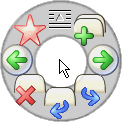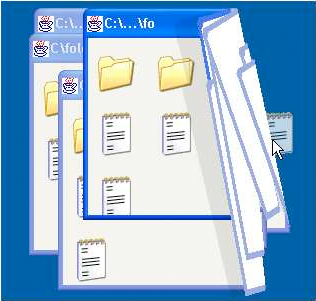Related Research Articles

A context menu is a menu in a graphical user interface (GUI) that appears upon user interaction, such as a right-click mouse operation. A context menu offers a limited set of choices that are available in the current state, or context, of the operating system or application to which the menu belongs. Usually the available choices are actions related to the selected object. From a technical point of view, such a context menu is a graphical control element.

In user interface design, a pie menu or radial menu is a circular context menu where selection depends on direction. It is a graphical control element. A pie menu is made of several "pie slices" around an inactive center and works best with stylus input, and well with a mouse. Pie slices are drawn with a hole in the middle for an easy way to exit the menu.

Fitts's law is a predictive model of human movement primarily used in human–computer interaction and ergonomics. The law predicts that the time required to rapidly move to a target area is a function of the ratio between the distance to the target and the width of the target. Fitts's law is used to model the act of pointing, either by physically touching an object with a hand or finger, or virtually, by pointing to an object on a computer monitor using a pointing device. It was initially developed by Paul Fitts.

Usability can be described as the capacity of a system to provide a condition for its users to perform the tasks safely, effectively, and efficiently while enjoying the experience. In software engineering, usability is the degree to which a software can be used by specified consumers to achieve quantified objectives with effectiveness, efficiency, and satisfaction in a quantified context of use.
In user interface design, a menu is a list of options or commands presented to the user of a computer or embedded system. A menu may either be a system's entire user interface, or only part of a more complex one.

Accounts payable (AP) is money owed by a business to its suppliers shown as a liability on a company's balance sheet. It is distinct from notes payable liabilities, which are debts created by formal legal instrument documents. An accounts payable department's main responsibility is to process and review transactions between the company and its suppliers and to make sure that all outstanding invoices from their suppliers are approved, processed, and paid. Processing an invoice includes recording important data from the invoice and inputting it into the company's financial, or bookkeeping, system. After this is accomplished, the invoices must go through the company's respective business process in order to be paid.

In human–computer interaction, WIMP stands for "windows, icons, menus, pointer", denoting a style of interaction using these elements of the user interface. Other expansions are sometimes used, such as substituting "mouse" and "mice" for menus, or "pull-down menu" and "pointing" for pointer.

A graphical widget in a graphical user interface is an element of interaction, such as a button or a scroll bar. Controls are software components that a computer user interacts with through direct manipulation to read or edit information about an application. User interface libraries such as Windows Presentation Foundation, Qt, GTK, and Cocoa, contain a collection of controls and the logic to render these.
Requirements management is the process of documenting, analyzing, tracing, prioritizing and agreeing on requirements and then controlling change and communicating to relevant stakeholders. It is a continuous process throughout a project. A requirement is a capability to which a project outcome should conform.
Software as a service is a software licensing and delivery model in which software is licensed on a subscription basis and is centrally hosted. SaaS is also known as "on-demand software" and Web-based/Web-hosted software.
A menu bar is a graphical control element which contains drop-down menus.
Web analytics is the measurement, collection, analysis, and reporting of web data to understand and optimize web usage. Web analytics is not just a process for measuring web traffic but can be used as a tool for business and market research and assess and improve website effectiveness. Web analytics applications can also help companies measure the results of traditional print or broadcast advertising campaigns. It can be used to estimate how traffic to a website changes after launching a new advertising campaign. Web analytics provides information about the number of visitors to a website and the number of page views, or create user behavior profiles. It helps gauge traffic and popularity trends, which is useful for market research.

A dialogue system, or conversational agent (CA), is a computer system intended to converse with a human. Dialogue systems employed one or more of text, speech, graphics, haptics, gestures, and other modes for communication on both the input and output channel.

On-premises software is installed and runs on computers on the premises of the person or organization using the software, rather than at a remote facility such as a server farm or cloud. On-premises software is sometimes referred to as "shrinkwrap" software, and off-premises software is commonly called "software as a service" ("SaaS") or "cloud computing".

An interaction technique, user interface technique or input technique is a combination of hardware and software elements that provides a way for computer users to accomplish a single task. For example, one can go back to the previously visited page on a Web browser by either clicking a button, pressing a key, performing a mouse gesture or uttering a speech command. It is a widely used term in human-computer interaction. In particular, the term "new interaction technique" is frequently used to introduce a novel user interface design idea.
Projektron BCS is a web-based project management software for planning, managing and controlling a multitude of projects simultaneously.

Human–computer interaction (HCI) is research in the design and the use of computer technology, which focuses on the interfaces between people (users) and computers. HCI researchers observe the ways humans interact with computers and design technologies that allow humans to interact with computers in novel ways. A device that allows interaction between human being and a computer is known as a "Human-computer Interface (HCI)".
In computing, data as a service, or DaaS, is a term used to describe cloud-based software tools used for working with data, such as managing data in a data warehouse or analyzing data with business intelligence. It is enabled by software as a service (SaaS). Like all "as a service" (aaS) technology, DaaS builds on the concept that its data product can be provided to the user on demand, regardless of geographic or organizational separation between provider and consumer. Service-oriented architecture (SOA) and the widespread use of APIs have rendered the platform on which the data resides as irrelevant.
As a service (AAS) is a business model in which something is being presented to a customer, either internal or external, as a service. As-a-Service offerings provide endpoints for customers/consumers to interface with which are usually API driven, but can commonly be controlled via a web console in a user's web browser. The term XaaS can mean "anything as a service".
References
- ↑ "Gradmesser für neue Marktchancen - manager magazin". manager magazin. Retrieved 2017-04-11.
- ↑ Reichwald, Ralf; Piller, Frank (25 July 2009). Interaktive Wertschöpfung: Open Innovation, Individualisierung und neue Formen der Arbeitsteilung. 25 July 2009: Springer. p. 171. ISBN 9783834994400.
{{cite book}}: CS1 maint: location (link) Interaction cost , p. 171, at Google Books - ↑ Pies, Ingo; Leschke, Martin (1997). Mancur Olsons Logik kollektiven Handelns. Mohr Siebeck. p. 44. ISBN 9783161467677. Interaction cost , p. 44, at Google Books
- ↑ Peters, Hans-Rudolf (2000). Wirtschaftspolitik. Oldenbourg. p. 326. ISBN 9783486255027. Interaction cost , p. 326, at Google Books
- ↑ Raluca Budiu (2013-08-31). "Interaction cost: Definition". NN Group. Retrieved 2017-04-09.